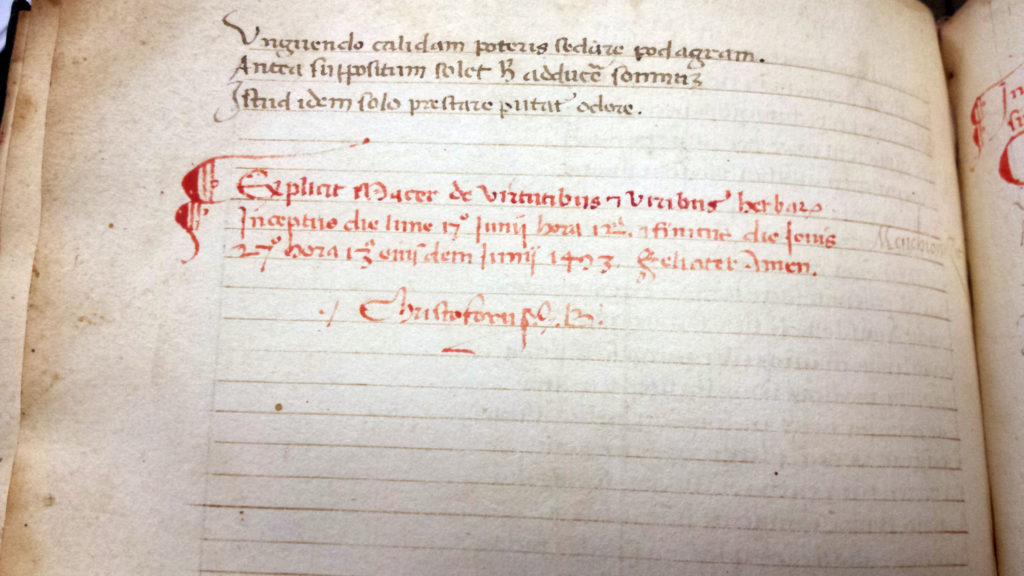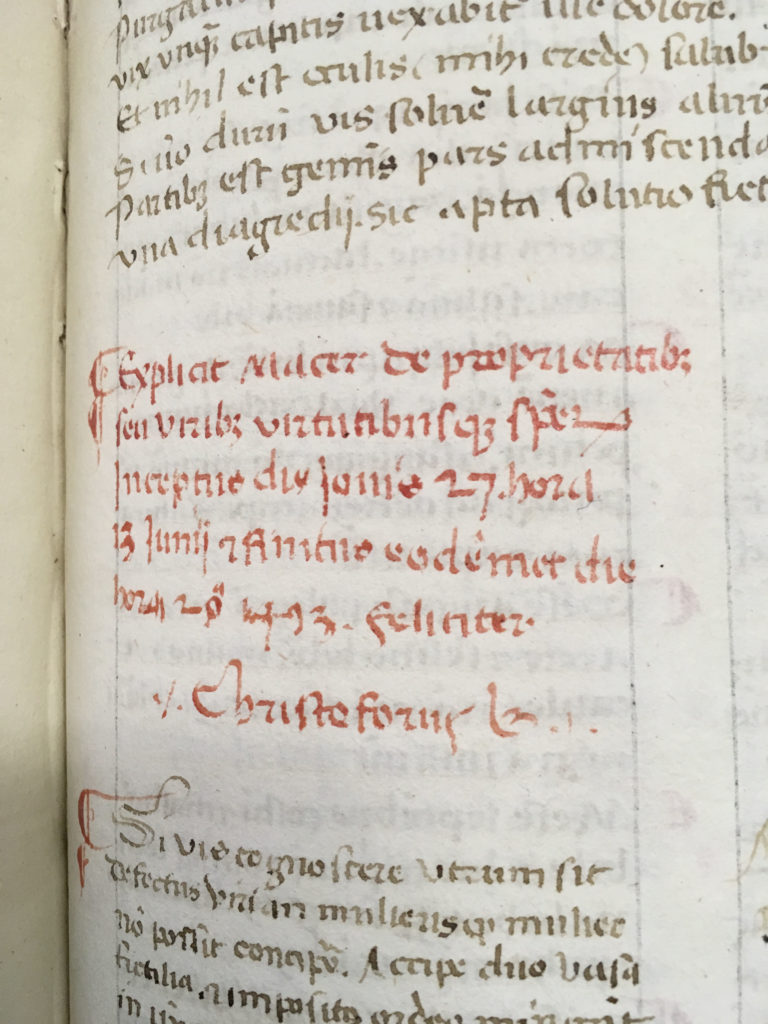It’s spring, and that means rhubarb! From strawberry rhubarb pie, to custard, to gin, this vegetable (most often used like a fruit) is either loved or hated by people the world over. Like many plants, rhubarb has been used medicinally for centuries, especially in traditional Chinese medicine. While the various species of rhubarb, and their distribution from Asian countries across the globe have been researched and discussed at length (see Sources and further reading for more), this post will examine the various types of rhubarb and their medicinal uses found in some of the Library’s herbals.
Herbals
Christoforus B. and De virtutibus herbarum
Dating medieval manuscripts can be tricky, as many of them aren’t dated by the scribe, nor do we know who the scribes were. However, 10a 159, Macer Floridus’ De Virtutibus Herbarum, has both a date and a name. We even know approximately how long it took our scribe to complete each section!
“Neither the rose nor the lily may overpass the violet”
Just in time for spring, we’re having a look this week at a medieval herbal and exploring the medicinal properties of the violet. 10a 159 is 15th century Italian manuscript and contains Macer Floridus’ De virtutibus herbarum, among other texts.

Exploring Herbal Medicine

Herbal medicine has been in use for millennia, with some of the earliest recorded instances being found in the ancient East, Middle East, and the Egyptians. Ancient Greeks and Romans relied on herbs for their healing properties, and early scholars like Aristotle (384 – 322 B.C.E.) and Theophrastus (371 – 287 B.C.E.) wrote about these plants and their healing properties. De materia medica (Latin for “medical material”) by Pedanius Dioscorides, written sometime between 50 and 75 C.E., is an early example of an encyclopedia and pharmacopoeia. Books like this would contain descriptions of plants, their traits, and recipes for medicinal use.
During the Middle Ages, herbal medicine was still a common form of treatment. The first printed books about it, called herbals, were printed in the late 15th century. Herbals contain illustrations or woodcuts of plants along with descriptions, traits, and medicinal recipes. Herbals remained popular well into the 19th century. The first synthetic drug was discovered and 1869, and synthetic drugs became more widely used during the next century and a half.
Near the end of the 20th century, more people began looking for alternatives to synthetic drugs and “re-discovered” herbal medicine. Today, many stores offer plant-based medicines and more medical practices offer integrative or alternative care.
The links below will direct you to the catalog record or finding aid of the resource listed. Remember to check our library catalog and finding aids – these are only some of the great sources we have about herbal medicine!
Primary sources
 Edgar Hewish recipe book of medical remedies and household mixture, undated
Edgar Hewish recipe book of medical remedies and household mixture, undated
Call number: 10a 434
 Timothy Hall recipe book, 1823-1834
Timothy Hall recipe book, 1823-1834
Call number: MSS 2/0285-01
 A course of fifteen lectures on medical botany…
A course of fifteen lectures on medical botany…
by Samuel Robinson, 1834
Call number: Qk 4b
 The sick man’s friend. Being a plain, practical medical work; designed for the use of families and individuals on vegetable, or botanical principles
The sick man’s friend. Being a plain, practical medical work; designed for the use of families and individuals on vegetable, or botanical principles
by P.E. Sanborn, 1836
Call number: Qk 25
 Paul Goddard “receipt” (recipe) book, circa 1857
Paul Goddard “receipt” (recipe) book, circa 1857
Call number: 10a 43
 Madame Young’s guide to health: her experience and practice for nearly forty years, a true family herbal ….
Madame Young’s guide to health: her experience and practice for nearly forty years, a true family herbal ….
by Amelia Young, 1858
Call number: WB 120 Y68m 1858
 Photograph: Medicinal herb peddler, circa 1870
Photograph: Medicinal herb peddler, circa 1870
Call number: Picture file #2
 Meals medicinal: with “herbal simples, ” (of edible parts) curative foods from the cook; in place of drugs from the chemist
Meals medicinal: with “herbal simples, ” (of edible parts) curative foods from the cook; in place of drugs from the chemist
by William Thomas Fernie, 1905
Call number: Qd 80
 Herbs for health; a concise treatise on medicinal herbs, their usefulness and correct combination in the treatment of diseases. A guide to health by natural means. With many black and colored illustrations
Herbs for health; a concise treatise on medicinal herbs, their usefulness and correct combination in the treatment of diseases. A guide to health by natural means. With many black and colored illustrations
by Otto Mausert, circa 1932
Call number: Yb 54
 The green pharmacy: new discoveries in herbal remedies for common diseases and conditions from the world’s foremost authority on healing herbs
The green pharmacy: new discoveries in herbal remedies for common diseases and conditions from the world’s foremost authority on healing herbs
by James A. Duke, 1997
Call number: WB 925 D877g 1997
Secondary sources
 Herbals, their origin and evolution: a chapter in the history of botany, 1470-1670
Herbals, their origin and evolution: a chapter in the history of botany, 1470-1670
by Agnes Robertson Arber, 1938
Call number: QK 15 A664h 1938
 Nature’s medicines: the folklore, romance, and value of herbal remedies
Nature’s medicines: the folklore, romance, and value of herbal remedies
by Richard Lucas, 1966
Call number: Qb 121
*Content written by Chrissie Perella, Archivist



